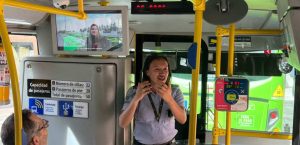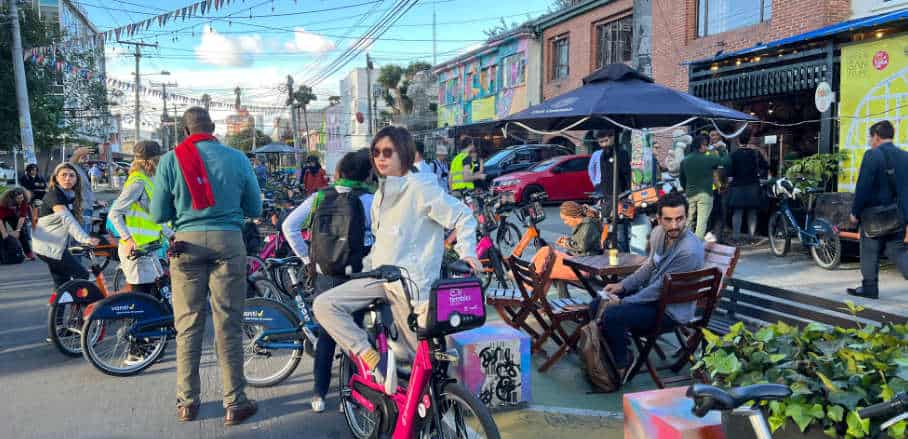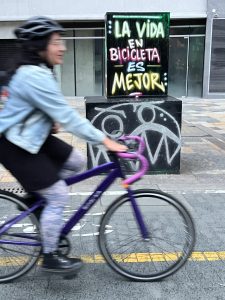Making Active Mobility and Public Transport a Winning Combination in African Cities: Inspirations from My Trip to Bogota
Following a visit to Bogota, Ulrich C. Tokam imparts invaluable insights for a transportation revolution in African cities.
Africa’s transportation sector faces a multitude of challenges, including rapid urbanisation, congestion, inadequate public transport infrastructure, and environmental concerns. As cities grow, the need for sustainable mobility solutions becomes increasingly urgent. My trip to Bogota, a city known for its commitment to sustainable and eco-friendly transportation, provided inspiring examples and valuable lessons that can be adapted to enhance mobility solutions in African cities.
Bridging the Gap: Creating Safe and Accessible Walking and Cycling Infrastructures
A cornerstone of Bogota’s transformation is its unwavering commitment to safe and accessible walking and cycling infrastructure, exemplified by wide sidewalks, dedicated bike lanes, and pedestrian-friendly crossings that have reshaped the city’s landscape, making it a haven for pedestrians and cyclists.

Well planned and resilient pedestrian and cycling lanes in Bogota © Cabrel Tokam
Bogota’s 2020 – 2024 Strategic Plan includes the goal of expanding the infrastructure to 830 km by 2024, which will considerably grow the number of cycle trips. In addition, Bogota established cycling as a priority mode of transportation in the city for future planning efforts in an official agreement from 2021.
Beyond Buses: Exploring Bogota’s Integrated Public Transport System
Beyond conventional buses, Bogota’s integrated public transport system, including the renowned TransMilenio BRT, has revolutionised urban mobility with a diverse network of electric buses, cable cars, and other modes ensuring efficient connectivity and accessibility.

A normal day at the gold museum BRT station in Bogota © Cabrel Tokam
An example that truly left a remarkable impression was witnessing the operational prowess of Bogota’s BRT system. The utilisation of large-capacity bi-articulated buses, coupled with strategic feeder services tailored for low-income neighbourhoods, is nothing short of impressive.
Notably, certain BRT terminals boast bicycle parking facilities designed to accommodate over 400 bikes, showcasing a holistic approach to mobility. Adding to this inspiration, Bogota stands as one of the rare cities globally that has integrated cable cars within its public transport network. This integrated approach to public transport reflects a larger paradigm shift in how cities function.
Championing Gender Equality in Transport: LA ROLITA
One of the most memorable site visits was to “LA ROLITA” (which means “Lady born and raised in Bogota”). LA ROLITA was proud to highlight its remarkable achievement of gender equity within its bus driver workforce, with an impressive 53% of drivers being women. In just eight months of operation, over 250 women have been successfully hired as drivers, marking a significant milestone in the transportation industry. This groundbreaking initiative aims to shatter barriers, defy gender stereotypes, and promote inclusive and sustainable public transportation.

Woman driver of la ROLITA sharing her experience with the company © Cabrel Tokam
I had the opportunity to engage with some of these women drivers, and their personal stories were truly inspiring. Reflecting on her journey, Geraldine, pictured above, expressed her gratitude for the opportunity she was given. “I can now contribute to the well-being of my little family and enjoy social security,” she shared with pride. She emphasised that “In Bogotá, one of the most common forms of violence against women is not physical violence but mostly financial violence.” Empowering women and providing them with equal opportunities in the transport sector can also help many cities especially in Africa, to tap into a vast pool of talent and contribute to gender equality goals.
Tactical Urbanism in Action: Transforming Streets into Vibrant Public Spaces
Tactical urbanism, a dynamic approach to urban design and planning, has been making waves in cities around the world, and Bogota is no exception. One of the most remarkable examples of tactical urbanism in Bogota is the renowned Ciclovía, a weekly event that temporarily closes major streets to vehicular traffic, allowing residents to reclaim the roadways for recreational activities.

A street completely reserved for pedestrians and cyclists in Bogota © Cabrel Tokam
Thousands participate fostering community, promoting healthy lifestyles, and igniting a sense of ownership. The success goes beyond the physical transformation of spaces; these interventions spark conversations, inspire creativity, and empower people to imagine what their city could become.
A Cultural Shift: Changing Attitudes Towards Active Mobility and Public Transport
Bogota’s successful transformation extends beyond infrastructure; it’s about transforming mindsets.

An example of street graphic promoting cycling in Bogota © Cabrel Tokam
Witnessing the city cultivate a cultural shift, encouraging its citizens to embrace active mobility and public transport as a way of life, was truly inspiring. One captivating aspect of this shift unfolds through the street graphics, which now define Bogota’s urban landscape.
Accompanied by catchy slogans advocating for walking and cycling as viable modes of transportation, they are part of a larger strategy to foster a cultural shift towards more sustainable choices. Pedestrians and cyclists are no longer seen as secondary users of the streets; they are protagonists in the narrative of a city that values their well-being and contribution to a greener environment.
Moving Forward: Embracing Bogota’s Experience in Africa’s Transportation Initiatives
The lessons learned from Bogota can be instrumental in shaping the future of transportation in Africa. Linking these lessons to ongoing African initiatives can to some extent chart a course towards sustainable, inclusive, and efficient transportation systems.
- Embrace Integration and Connectivity: African cities should prioritise creating cohesive transportation networks that allow for smooth transitions between different modes – be it buses, trains, cycling lanes, or pedestrian pathways.
- Explore Innovative Funding Models: Inspired by Bogota’s funding mechanisms, African nations should explore diverse funding models, including public-private partnerships, sustainable urban mobility funds, and innovative financing mechanisms like congestion pricing or value capture.
- Champion Gender Inclusivity: Learning from Bogota’s example, African transportation initiatives should consider implementing women-focused initiatives, such as women-only transport options, ensuring well-lit and safe spaces, and promoting women’s participation in all levels of the transportation sector.
- Invest in Efficient Mass Transit Systems: Bogota’s efficient transit system can inspire African cities to invest in transformative systems – BRT, light rail, and metro networks – reducing travel times, congestion, and enhancing urban connectivity and accessibility, especially for marginalised communities.
